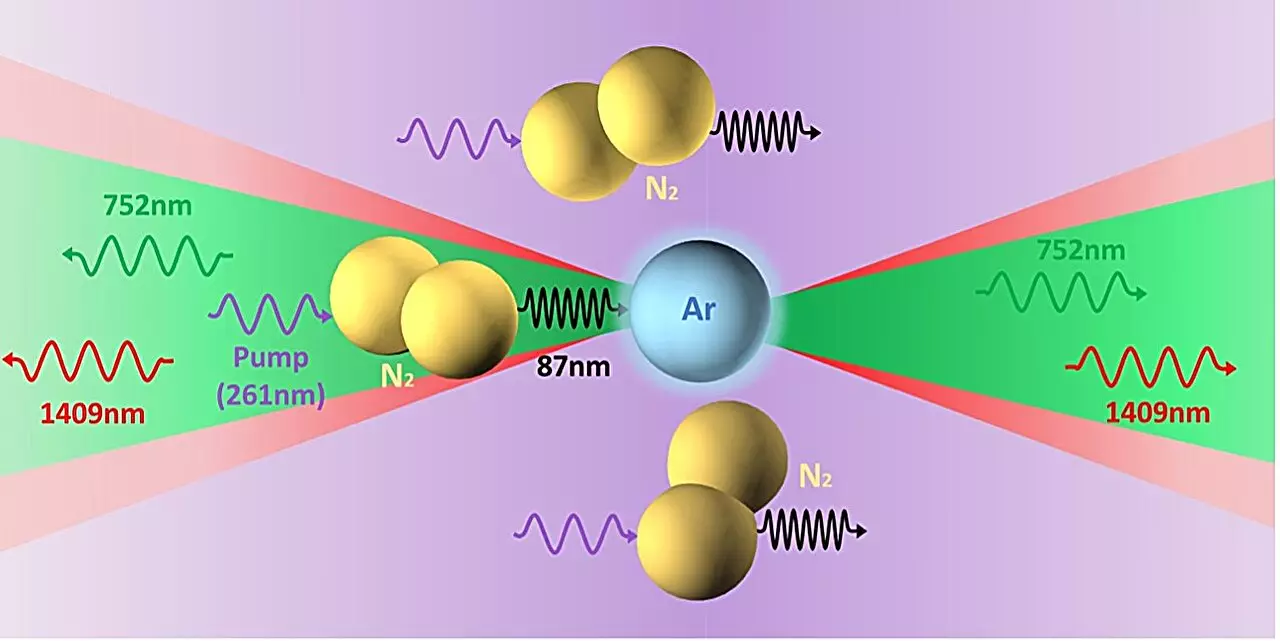In the landscape of modern photonics, the advent of lasers has revolutionized fields ranging from medicine to communications. Conventional lasers depend on optical cavities, utilizing pairs of mirrors to amplify light. However, recent groundbreaking research has brought to light a novel phenomenon: cavity-free lasing in atmospheric air. This article delves into the findings of physicists from the University of California Los Angeles (UCLA) and the Max Born Institute, who have made strides in understanding the generation of laser-like emissions without traditional optical setups.
The researchers at UCLA and the Max Born Institute have unveiled a previously unrecognized mechanism that facilitates the generation of “laser light” in the open atmosphere. As described in their publication in *Physical Review Letters*, this intriguing phenomenon arises from a photon-mediated energy transfer between nitrogen (N₂) and argon (Ar). Co-author Chan Joshi highlighted that they stumbled upon a significant reduction in the ionization rate of argon under high field ionization conditions; this discrepancy sparked further investigation into the dynamics at play with a certain excitation wavelength.
The 261 nm pump laser serves as the driving force behind these observations. The research team proposed that a three-photon resonant absorption process of these specific photons within argon atoms could be crucial in altering expected ionization rates. This investigation not only builds upon previous experimental foundations but also sets a pathway for understanding lasing outside conventional parameters.
Finding that the three-photon absorption leads to cascaded superfluorescence—essentially coherent light emission without a cavity—marks a significant milestone in photonic research. Lead author Zan Nie noted surprise at their observation: when 1% argon was mixed with air, the team witnessed a shift in emitted wavelengths during the superfluorescence process. This unexpected observation hinted at a more complex interaction between nitrogen and argon, prompting them to explore this newly discovered air lasing mechanism in greater depth.
The revelation of bidirectional and two-colored cascaded lasing signifies crucial advancements in light manipulation within atmospheric conditions. Traditional camera shoots or optical sensors heavily depend on well-defined light sources. However, the ability to create such lasing phenomena in air suggests profound implications for remote sensing technologies as well as advances in communication systems.
The Role of Nitrogen in Air Lasers
Underpinning the mechanism described by the researchers is the role of nitrogen molecules. When nitrogen is present alongside argon, it not only affects the ionization properties of argon but also creates favorable conditions for energy transfer that trigger lasing. Joshi explained how their experiments demonstrated that it was the coupling between nitrogen and argon that yielded successful lasing results, particularly when oxygen or helium was absent from the mixture. This indicates that specific atmospheric compositions are crucial to the mechanics of lasing, providing insight that could lead to tailored atmospheric experiments for specific applications.
The team additionally showcases that nitrogen molecules, when electronically excited, exhibit non-linear-3-photon absorption effects at slightly adjusted frequencies. These characteristics serve as precursors to the cascaded superfluorescence identified during their experiments, further elucidating the mechanics involved in this cavity-free lasing process.
The Forward Path: Prospects for Future Research
The enthusiasm surrounding cavity-free lasing does not merely stem from its novelty but from its potential applications. In many ways, the challenges posed by traditional lasing setups are circumvented with this approach. As co-author Misha Ivanov emphasized, the compelling objective is to achieve a practical form of lasing that can be projected and returned—in essence, facilitating two-way light communication in atmospheric conditions.
Looking forward, the research team aims to explore even finer details of the observed effects, including quantum phenomena such as quantum beating. The oscillations arising from the simultaneous excitation of energy levels in argon could unveil insights into previously unknown atomic levels, enriching the understanding of nitrogen’s vibrational and rotational dynamics in the context of radiative coupling.
The discovery of cavity-free lasing represents an intersection of fundamental physics and practical application, echoing with the promise of redefining how we comprehend and utilize light. As research in this domain expands, it beckons exciting possibilities not just in theoretical exploration but also in impactful advancements across multiple practical applications. By examining the intricate dance of molecular interactions in the air we breathe, scientists stand poised to unlock a new realm of photonics.


Leave a Reply